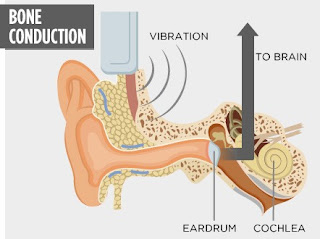Bone conduction has rapidly become a critical asset for treatment of hearing loss. While a new generation of cochlear implants has had spectacular success in recent years, they rely on air conduction and the patient possessing a functional pathway from outer to inner ear. For patients with severely damaged pathways, such implants offer no solution.
Baha (bone anchored hearing aids) units work by passing sound from a microphone to a magnet or implant beneath a patient's skin, which is converted into vibrations in the skull and eventually arrives at the inner ear. This process extends the miracle of restored hearing to victims of such conditions as microtia or atresia, where the ear or canal is closed or deformed.
"It's the natural spectrum of sound compared with traditional hearing", says Brian Walshe, spokesperson of hearing treatment company Cochlear. "Even with amplification it's the same, there's no distortion."
The company recently launched a wireless Baha set, an indication of the technology's progress and growing popularity. Implants have become smaller and less invasive, while cosmetics have improved so that the system can be worn without advertising it.
Bone conduction is not a new discovery. Ludwig Van Beethoven overcame deafness by biting a metal rod attached to his piano to hear his work. Neither do they need to be compensation for disability - such systems have been used by the military in environments that require awareness as well as audio instructions. A member of the SEAL team which killed Osama Bin Laden wrote in his autobiography that bone conduction communication was critical to coordinating the raid.
The innovation is beginning to seep into consumer electronics. In the early 2000s, headphone sets appeared that played music via the user's bones, but the systems were hamstrung by high cost and low quality, with common complaints about muffled and distorted sound. The makers of Aftershokz believe they have solved those problems with a unit that retails for $79.
"The difficulty for bone conduction has been transmitting vibrations through bone with enough power for music, you need to be on the 20 - 20,000 Hz frequency range," says CEO Bruce Borenstein. "We have been able to power dual transducers with enough vibration to make the sound musical, which has been our big breakthrough."
The bone conduction system offers key safety advantages over traditional earphones, by leaving the user's ears free so that they are not distracted from their environment. It is even possible to drive wearing them, as they comply with the legal requirement to be able to hear on the road. The Audiology Foundation of America has also supported the concept, stating that it causes less damage to the ears than earbuds.
A flood of competitors are entering the market and innovation is not limited to headphones. Google Glass is
using bone conduction rather than earbuds for their speaker system, although there have been teething problems. Multiple patents are emerging for underwater and deep sea communication systems, and the technology has become cheap and accessible enough to be viable for novelty items such as talking pillows.







0 comments:
Post a Comment